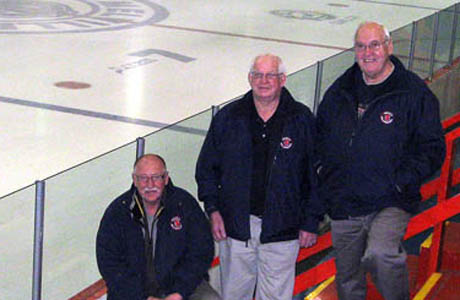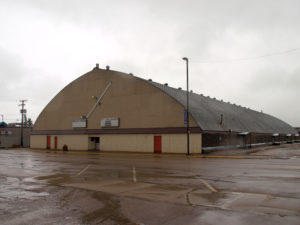The museum located at 101 - 3rd Ave W in Melville highlights more than 100 years of Millionaire history
THE STORY BEHIND THE TEAM

Richard "Bunker" Hill, Howard Sanftleben and Ernie lluk
Millionaires boosters Richard Hill, Howard Sanftleben and Ernie Iluk enjoy a moment at the historic Stadium, about to give way to the new Melville Communiplex. Photograph by: Ron Petrie, Leader-Post
Let's have a go at some word association, Saskatchewan-style. I say "Melville." You say...?
Uh-huh.
Millionaires.
In all of Saskatchewan sport, no name is older, odder or woven tighter into the very soul of its community. For almost 100 years the Millionaires have been at it, in baseball, minor sports and, as a flagship team, in the province's senior, intermediate and junior hockey leagues, upholding a community pride that, in truth, was built not on gaudy bank accounts, but on grain deliveries and working folks' paycheques.
The century mark is always good pause for memories, which is how we find ourselves today inside one marvelous old barn, a Saskatchewan landmark, the Melville Stadium, and in the wee office of the SJHL Millionaires coach and general manager Jamie Fiesel. I'm guessing that our gabfest on hockey and all things Melville is but one of 10,000 such hotstoves at the downtown arena during its past half century, and perhaps a bit melancholic for long-time club boosters Ernie Iluk, Richard "Bunker" Hill and Howard Sanftleben.
Only a few blocks west, crews have leveled ground for a new $24-million building, the Melville Communiplex, and the current hockey season begins a countdown to the final days of the wooden-arched dome rink. Long planned, at times dismissed as daydream, the new 1,500-seat arena, cardiac care centre and convention hall turned into a real deal earlier this year when it was approved for $8.2 million in federal economic stimulus grants, money the province immediately vowed to match. It was a windfall that stunned Melville.
"Over there," says Hill, back at the Stadium, pointing in the general direction of an equipment room and one of his earliest recollections of the current Millionaires, 1970 entries in a fledgling SJHL after an upheaval a few years earlier in hockey politics left Melville to compete mainly in senior leagues.
Hill took on the task of equipping the revived junior Millionaires. "It was a mess. Mice had gotten into everything. I was pulling out equipment, and there was the name, Abel."
Sid Abel, a Detroit Red Wing Hall-of-Famer, at one time wore the Millionaires crest, as did NHL bruisers Eddie Shore and John Ferguson, followed more recently by goalie Ron Hextall and last spring's Stanley Cup hoister, Pittsburgh Penguin Chris Kunitz.
"You know what they let me spend that first year for tape, gum and laundry?" says Hill. "Ten dollars a week. Ten dollars." Which is to say that few bona fide millionaires -- modern-day NHLers, aside -- have ever been associated with the Millionaires. Created as a major service centre of the Grand Truck Pacific Railway, Melville first achieved its city status with the requisite population of 5,000 in 1960. But like so many small Saskatchewan towns surrounding it, Melville found that the railway both gives and takes. In recent decades the population has floated at about 4,300 residents, the smallest of the province's cities .
Fiesel, who spent seven years with the Millionaires after a 16-year career overseas in German hockey, was raised in Regina and marvels at Melville's resiliency as a city that, by municipal definition, ought to be a town. "Take the Regina Pats. They have a city of 200,000 for support. When we go out for sponsorships, we're hitting the same people, the same business, over and over and over. And they always come through. Always." Not many other hockey teams see their logos on banners strung from light standards along downtown streets, where in other cities a civic emblem or a Chamber of Commerce slogan would hang. In Melville's minor hockey system, when two teams compete at the same level, the coin flip is for which one gets to calls itself the "Millionaires" and which is relegated to mere "Billionaires."
And why the Millionaires?
Great story: Melville was named after Charles Melville Hayes, the Grand Trunk Pacific general manager who drowned in the 1912 sinking of the Titanic. Great story has it that aboard the ship was a group of millionaires that Hayes was bringing over as potential investors in Melville.
True story? In 1914-15, local hockey pioneer Goldie Smith assembled a senior team that won the Allan Cup, the championship of Canadian senior hockey, then a challenge trophy monopolized by the likes of Winnipeg, Ottawa and the eastern universities. Grumbling ensued that Melville must be some town of millionaires to lure players of such caliber. Smith's thinking was, hey, whatever gets their big-city goat. The name stuck, five years before anybody in Saskatchewan had heard of the football Roughriders.
To this day, that Allan Cup championship remains the pinnacle of Millionaire hockey. Despite a few near-misses, the SJHL championship remains elusive, although under Fiesel's management, the playoff runs have stretched longer, last spring to a final series against Humboldt. He recalls one moment early on of realization of what it meant to be a Millionaire, and the community attention that came with his new office. "We were on the ice, practicing before a playoff game. People were walking into the rink, dropping blankets in the stands, and then just leaving. Blankets everywhere. Blankets? I'm, like, what's up with blankets?" Turned out the blanket folks were fans reserving their seats for the game. For season-ticket holders, the Millionaires screw a blue metal plaque to their choice spots on Stadium bench seating. No armrest theatre seating here. Similar to how Melville is as much a town as a city, the Stadium itself puts one in mind of the tin-sided, dome-style post-war memorial arenas, once the province's architectural standard for rural hockey. Except much bigger, of course. Its seating capacity is often listed at 2,800, or at 2,300 to be safely within fire regulations, larger than most SJHL arenas.
 Yet the rink was never supposed to be. Fire in 1948 destroyed Melville's original Queen Street Rink. The first Melville Stadium, built for $76,000, burned down in 1955. Actually an insurance settlement, the reconstructed Stadium in its day was still a one-up on the city 30 minutes to the northeast, arch-rival Yorkton. (For the record, Melville people do not actually spit after every spoken mention of "Yorkton." I did, however, note that eyeballs do roll.) From long-ago days when a train, the "Whiskey Special," shuttled fans between games in Melville to Yorkton, if not always returning with the same upright passenger count, parkland smackdowns remain the fiercest inter-city rivalry in the province.Yet when asked for their one most memorable game in the Stadium, Hill, Iluk and Sanftleben agree that the visitors were not the Yorkton Terriers, but rather the Flin Flon Bombers and a contingent of fans who made the six-hour road trip south for the seventh game of an SJHL final in 1993.
Yet the rink was never supposed to be. Fire in 1948 destroyed Melville's original Queen Street Rink. The first Melville Stadium, built for $76,000, burned down in 1955. Actually an insurance settlement, the reconstructed Stadium in its day was still a one-up on the city 30 minutes to the northeast, arch-rival Yorkton. (For the record, Melville people do not actually spit after every spoken mention of "Yorkton." I did, however, note that eyeballs do roll.) From long-ago days when a train, the "Whiskey Special," shuttled fans between games in Melville to Yorkton, if not always returning with the same upright passenger count, parkland smackdowns remain the fiercest inter-city rivalry in the province.Yet when asked for their one most memorable game in the Stadium, Hill, Iluk and Sanftleben agree that the visitors were not the Yorkton Terriers, but rather the Flin Flon Bombers and a contingent of fans who made the six-hour road trip south for the seventh game of an SJHL final in 1993.
Iluk now shudders at what could have happened that night, in a rink fused for a riot. "I left work at a quarter to five and already there were seven STC buses lined up at the rink, people waiting to get in, and I thought, uh-oh." News accounts of the game reported 3,366 spectators, officially, and with hundreds more crashing gates after all standing room was exhausted. During play stoppages, Flin Flon fans pelted the ice with fish, and Melville supporters responded with eggs and, at one point, a squid. RCMP ejected fan after fan, many in handcuffs. The Bombers posted a 5-3 win. "Some of the high school kids brought dissection frogs to toss on the ice," recalls Bob Richardson. "I swear, some of those frogs were as big as jack rabbits." After the cleanup, trash bins of fish, frogs and assorted other aquatic species were inadvertently forgotten in a storage room, with predictable results.
A player himself the 1960s, Richardson has amassed a collection of Millionaires memorabilia, hundreds of programs, ticket stubs and sweaters that, for community events, he displays as the "100 Years of Hockey History Museum." Among his pieces are two amateur status cards held by players of the 1915 Allan Cup team. "Just make sure it's the Millionaires you write," he tells me. "Not the Mils. Man, I hate that. Nobody goes around shortening the names of other SJHL teams." The new Communiplex will change Melville, for both residents and travelers along Highways 10 and 15, the interchange not far from the construction site. "It's really going to be something to see, lit up at night, from the overpass, at the city's entrance," says Fiesel. That's the same railway overpass, legend has it, where coach Gerry James, after road losses in the mid-1970s, would have the team bus "run out of gas" and be pushed into town by the team.
More memories.
"It's going to be sad, I'm sure, when we say farewell to the Stadium," says Iluk. "Mixed feelings, I suppose. The way you have to look at it as, hey, we're moving ahead, to a fine new building, into the future, and still as the Millionaires."And with those million-dollar memories. These guys, they've got a million of them.
© Copyright (c) The Regina Leader-Post















